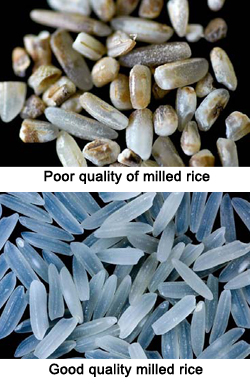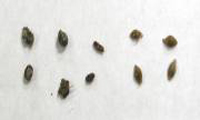Physical quality of milled rice
 What is physical quality of milled rice?
What is physical quality of milled rice?
The physical quality of milled rice is characterized by a combination of desirable and measurable characteristics. In line with the market requirements, these are used to classify rice into grades which varies for different countries. Rice grades depend on the buyers' preferences.
What are the physical characteristics used to measure milled rice quality?
Milling degree
The degree of milling or the percentage of brown rice removed as bran affects the level of white rice recovery and influences consumer acceptance. Grades range from under-milled, well-milled to extra well-milled. Well-milled rice has normally 10% of rice removed during whitening. Milling degree influences the color and also the cooking behavior of rice as under-milled rice absorbs water slowly and does not cook well.
Whiteness
This characteristic is a combination of varietal and physical characteristics as well as the degree of milling. Whiteness is measured by a colorimeter or as an index number from a whiteness meter. It is often used to determine milling degree. Brown rice gives a reading of approximately 20 on the whiteness meter, whereas well-milled rice is close to 40.
Head rice
The head rice percentage is the volume or weight of head rice or whole kernel in the rice sample. Head rice normally includes broken kernels that are 75-80% of the whole kernel. High head rice yield is one of the most important criteria for measuring milled rice quality. Head rice yields in Asia range from 35 to 50% of total paddy weight.
Damaged grains
These are whole or broken grains showing damage due to moisture, pests, diseases, or other causes, excluding heat damage. In some instances, discolored grains are also separated into another category.
Chalkiness
Grain appearance is largely determined by the opacity and is commonly classified as the amount of chalkiness. Opaqueness has an overall chalky texture caused by an interruption of the final filling of the grain. Though chalkiness disappears upon cooking, excessive chalkiness downgrades the quality and reduces milling recovery.
Red kernels and red-streaked kernels
Red kernels have a red coloration covering more than one quarter of their surface while red streaked kernels have red streaks that are longer than half of the whole kernel but where the surface covered is less than one quarter of the total surface.
 Foreign matter
Foreign matter
Foreign material relates to the presence of organic and inorganic material in the grain other than rice. This includes things such as stones, weed seeds, soil and plant material.
Moisture content
The allowable moisture content will vary in each country but will normally range from 13 to 15%.
For more information:
Visit the Rice Knowledge Bank website (http://www.knowledgebank.irri.org), email postharvest@irri.org; or call +63 2 580 5600.







